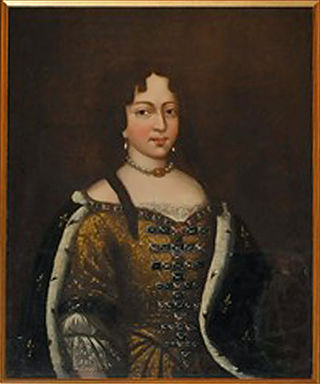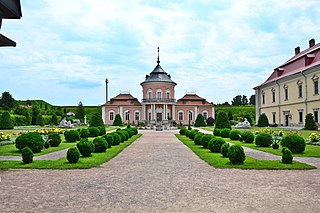Stare Selo Castle is a castle in Stare Selo village, Lviv Raion, Lviv Oblast, Ukraine. This castle, or fortress, was built by the princely Ostrogski family.
Its original timber fortifications, first mentioned in 1448, were destroyed by the invading Turks in the late 15th century. A more secure stone fort, intended to defend the Bârlad Road from Lviv to Romania, was built in Stare Selo in the 1580s. Those walls were breached and rendered useless by Khmelnytsky's Cossacks during the Siege of Lviv in 1648.
The existing fortress, almost triangular in shape, with 15-metre high walls and a ceremonial gate on the south side, was commissioned by Prince Władysław Dominik Zasławski, one of the last members of the Ostrogski family. The citadel was erected in 1649-54 and formerly contained the palatial residence of Prince Zaslawski, one of the richest landowners of Eastern Europe and brother-in-law of King John III Sobieski.
After Prince Zaslawski died in Stare Selo in 1656, the fortress gradually fell into disrepair, although it successfully withstood a siege by the Turks in 1674.
Stare Selo Castle of Prince Zaslawski

Ostroh is a historic city located in Rivne Oblast (province) of western Ukraine, on the Horyn River. Ostroh was the administrative center of the Ostroh Raion (district) until 2020. Administratively, Ostroh is incorporated as a city of oblast significance and does not belong to the raion. Population: 14,894.

Ostrogski is a Polish coat of arms of the Polish–Lithuanian Commonwealth. A variant of the Leliwa and Ogończyk coat of arms.

The House of Ostrogski was one of the more prominent families in the Kingdom of Poland, the Grand Duchy of Lithuania and in the Polish–Lithuanian Commonwealth. The family spanned from the 14th century Ruthenian noble Daniil Ostrogski to the 17th century Polish members. After the death of Janusz Ostrogski, the last male heir, most of the family's possessions passed to the Zasławski family.

Prince Janusz Ostrogski was a Polish-Lithuanian noble and statesman. He served as a voivode of Volhyn (1584-1593), as a castellan of Kraków, and as a starosta of Bohuslav, Biała Cerkiew, Czerkasy and Kaniów, Perejasław and Włodzimierz.

Princess Teofila Ludwika Zasławska was a member of the Polish nobility, known as the perhaps most significant heiress and landowner of her contemporary Poland.

Prince Wladysław Dominik Zasławski-Ostrogski was a Polish nobleman (szlachcic) of Ruthenian stock. Prince of the Princely Houses of Poland, Ostroh Ordynat, Grand Koniuszy of The Crown.

The Battle of Trembowla, more popularly known as the Defence of Trembowla took place between September 20 – October 11, 1675, during the Polish-Ottoman War (1672-1676). Heroic resistance of Polish forces became a symbol, and was glorified and immortalised in the paintings of Franciszek Smuglewicz, Józef Peszka and Aleksander Lesser.

Dubno is a city and municipality located on the Ikva River in Rivne Oblast (province) of western Ukraine. It serves as the administrative center of Dubno Raion (district). The city is located on intersection of two major European routes, E40 and E85. The city is estimated to have a population of 36,901 . It is located within the historic region of Volhynia.

The Battle of Akhaltsikhe may refer to one of the following:

The Lviv High Castle is a historic castle located on the top of the Castle Hill of the city of Lviv, Ukraine. It is currently the highest point in the city, 413 metres (1,355 ft) above sea level. The castle currently stands in ruins.

Sedan Castle is a castle situated in Sedan, France, near the river Meuse. Covering an area of 35,000 square metres (380,000 sq ft) in its seven floors.

Pidhirtsi Castle is a residential castle-fortress located in the village of Pidhirtsi in Lviv Oblast (province) western Ukraine, located eighty kilometers east of Lviv.

Kamianets-Podilskyi Castle is a former Ruthenian-Lithuanian castle and a later three-part Polish fortress located in the historic city of Kamianets-Podilskyi, Ukraine, in the historic region of Podolia in the western part of the country. Its name is attributed to the root word 'kamin', from the Slavic word for 'stone'.

The Ternopil Castle is a stronghold which gave birth to the city of Ternopil. It was built in the 16th century to protect the southern border of the Kingdom of Poland and the Polish–Lithuanian Commonwealth.

Zolochiv Castle was a residence of the Sobieski noble family on a hill at the confluence of two small rivers in the south-eastern part of Zolochiv, Galicia.

The ruined Kudryntsi Castle is perched on a hilltop overlooking the Zbruch River in Chortkiv Raion, Ternopil Oblast, Ukraine, 25 km west of a larger fortress in Kamianets-Podilskyi. It was built in the early 17th century by Jan Szczęsny Herburt and throughout the ensuing century was subjected to repeated sieges by the Cossacks and the Turks. By the 19th century, some portions of the walls had crumbled away, and the structure was left to its fate.

Dubno Castle was founded in 1492 by Prince Konstantin Ostrogski on a promontory overlooking the Ikva River not far from the ancient Ruthenian fort of Dubno, Volhynia.

The House of Zasławski was the name of a Polish–Ruthenian noble family and a cadet branch of the Ostrogski family. The Zasławski family had its power base in Volhynia, Crown of the Kingdom of Poland, and traced its origins to a branch of the Rurikids that took its name from the Iziaslav. Due to their relation to the Rurikids, the Zasławski family held the title of Knyaz (prince).
Stare Selo is a village in Lviv Raion, Lviv Oblast, Ukraine known as the site of a large castle, or rather fortress, of Princes Ostrogski. It belongs to Davydiv rural hromada, one of the hromadas of Ukraine.

The Starokostiantyniv Castle is a Volhynian castle built at the confluence of the Sluch and Ikopot' rivers by Prince Konstanty Wasyl Ostrogski in the 1560s.

















